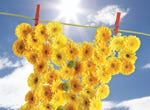.png?width=700&auto=webp&quality=80&disable=upscale)
Natural liquid and powdered laundry products accounted for a combined $21 million in sales during the 12-month period ending in October 2010, up more than 3 percent over the previous 12 months, according to data from Schaumburg, Ill.-based market-research firm SPINS. But that’s just a fraction of the total laundry detergent market.
February 26, 2011

Be it premium or bargain, natural or mainstream, laundry detergent is a product shoppers will continually put in their carts. Natural liquid and powdered laundry products accounted for a combined $21 million in sales during the 12-month period ending in October 2010, up more than 3 percent over the previous 12 months, according to data from Schaumburg, Ill.-based market-research firm SPINS. But that’s just a fraction of the total laundry detergent market.
“This is a highly penetrated, highly consumable category,” says John Murphy, senior vice president of sales for Seventh Generation, a manufacturer of green-cleaning products in Burlington, Vt. “It’s a $5 billion category, and grocery stores can count those categories on two hands.”
Natural laundry products—including liquid and powdered detergents, stain removers, fabric softeners and dryer sheets—tend to command a premium price by virtue of their “natural” tag, Murphy says. But they can also command premium shelf space because of their bulk, so it’s key to understand the trends in this category and how natural products stack up against top mainstream brands in order to determine the right product mix. Follow these tips to generate repeat sales.
 Hot trends for clean clothes
Hot trends for clean clothes
Why do shoppers choose natural over conventional when it comes to laundry products? Though environmental impacts are important, “the number-one reason people go with a natural brand is to reduce the number of chemicals in their home and on their skin,” Murphy says. It makes sense, then, that trends in this category focus on effective natural alternatives to common ingredients.
“There’s a big shift toward using natural plant-derived surfactants,” says Robin Kay Levine, president of Eco-Me, a natural household cleaner manufacturer based in Pasadena, Calif. Surfactants, a primary cleaning agent in many detergents, are commonly made of petroleum byproducts. “Using petrochemical surfactants results in waste water with higher salts and alkalinity,” says John Vlahakis, president of Earth Friendly Products, based in Addison, Ill. “The balanced pH of plant-based surfactants is gentler on the skin, and clothes last longer.”
Because labels don’t always disclose enough information for retailers to discern a surfactant’s ingredients, Levine suggests asking manufacturers. The data you receive can then be shared with customers through information sheets or shelf talkers.
Another trend Levine’s tuning into in the naturals category is a return to essential oils instead of synthetic fragrances. Though more expensive to formulate, products made with essential oils have added cleaning benefits, she says. Many essential oils, including thyme, lavender and lemon, not only smell great but also are effective antibacterial ingredients.
But do these natural products actually work?
Can natural detergents meet the same standards as premium mainstream brands? Manufacturers know customers will not change to natural products unless they work as well as what they currently use, Levine says.
Many natural formulations are now 90 percent as effective as the leading premium brand, Murphy says. That missing 10 percent? Optical brighteners, which are fluorescent blue-tinted dyes that have no natural counterpart. Mainstream products that use these additives actually glow under ultraviolet light, and in daylight they add a bright sheen that Murphy likens to “millions of tiny mirrors” on your clothing.
Because natural laundry products have a wide range of efficacy, Murphy suggests segmenting them by value—mid-tier and premium. “There’s not a link between efficacy and price, and that’s the white elephant in the room,” he says. “There’s a huge gap in terms of how different brands perform.”
Because retailers don’t have a product-performance database they can reference, the best way to market natural detergents is simple—sample. “We distribute hundreds of thousands of trial-size samples,” Murphy says. “If you want someone to pay $13 for 100 ounces of detergent, they’re going to want to try it first.”
Natural laundry product picks
Seventh Generation SVG 4X Liquid Laundry Detergent
Launching at Natural Products Expo West this year, this detergent is packaged in a new Ecologic bottle that is made from 100 percent post-consumer materials, is compostable and uses 70 percent less plastic than comparable products. The detergent is formulated with additional enzymes for greater stain-removing power, and contains no dyes, synthetic fragrances or optical brighteners.
Biokleen Cold-Water Formula Laundry Liquid
Because this detergent is just as effective in cold water, it reduces the amount of energy needed per wash. It can also be used as a pre-treatment for stains.
Earth Friendly Everyday Stain & Odor Remover
This product uses enzymes and coconut-based surfactants to remove stains from laundry, fabric and carpet, as well as odors caused by food, dirt, urine and other natural substances.
Eco-Me Emma Laundry Soap
This liquid detergent made from castile soap; olive, coconut and aloe oils; and essential oils of Roman chamomile, grapefruit and clary sage has a unique, sweet tea scent. It’s free of surfactants, parabens and preservatives, and is recommended for gentle machine cycles and hand-washing delicate items.
About the Author(s)
You May Also Like




